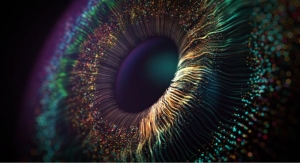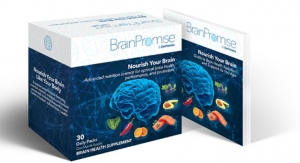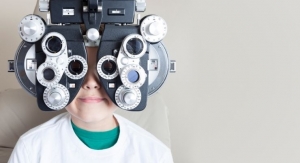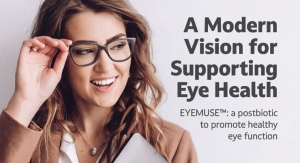By Sean Moloughney, Editor05.01.17
Traditionally an area of focus for people later in life, maintaining healthy eyesight remains a top concern that extends to consumers across the age spectrum. Many experts today are concerned about the long-term health implications of overexposure to blue light from digital devices, especially for younger eyes.
For instance, according to a Harvard Health Publications newsletter, blue wavelengths in moderation are beneficial during daylight hours because they boost attention, reaction times, and mood. However, they can be especially disruptive at night, shifting circadian rhythms and suppressing melatonin. Overexposure can also lead to eye fatigue.
Glaring Health Issues
Statistics indicate eye diseases affect millions of consumers. By age 75, approximately half of all Americans have cataracts, according to the National Eye Institute (NEI). Glaucoma affects more than 2.7 million Americans age 40 and older, and nearly 2.1 million Americans age 50 and older have late age-related macular degeneration (AMD), the stage that can lead to severe vision impairment. By age 80, one in 10 Americans will have late AMD. In 2010, 9.1 million Americans had early AMD.
The prevalence of diabetes is increasing in the U.S, (currently 29 million Americans), leading to a range of related health problems. Diabetic retinopathy, for example, is the most common diabetic eye disease and a leading cause of blindness in American adults. From 2010 to 2050, the number of Americans with diabetic retinopathy is expected to nearly double, from 7.7 million to 14.6 million, according to the NEI.
Meanwhile, an estimated 60% of adults use digital devices more than five hours daily, according to a 2016 report from the Vision Council, a trade organization dedicated to educating the public about eye health and eyewear, titled “Eyes Overexposed: The Digital Device Dilemma.” Additionally, 70% of Americans use two or more devices at the same time, and 75% of these people report experiencing symptoms of digital eye strain.
The American Optometric Association’s (AOA) annual American Eye-Q survey identifies attitudes and behaviors of Americans aged 55 and older regarding eye care. According to the 2015 survey, 47% of respondents feared losing vision, more than their memory (31%) or ability to walk (13%).
“Vision and cognition are the two functionalities that Americans most fear losing,” said Ceci Snyder, global vision product manager, Kemin, Des Moines, IA. “Maintaining eye health is an important part of active aging because it affects quality of life.”
Vision loss is often a significant part of the changes experienced throughout the aging process, but lifestyle and diet can play a role in preservation, said Sébastien Bornet, vice president of global sales and marketing at Horphag Research (exclusive worldwide supplier of Pycnogenol).
“As we get older, vision changes become more noticeable (e.g., changing lenses or contacts more often for a stronger prescription, more difficulty reading small print, etc.). So it becomes more of a priority as consumers seek overall wellness.”
A Spectrum of Consumers
Consumers over the age of 50 continue to be the main buyers of eye health supplements and natural nutritional products, according to Golan Raz, vice president of health & nutrition at Lycored (part of Adama Group). “Within this large group, there are two main sub-groups,” he said. “The first is people with early indication of either loss of vision or early stages of eye disease (in most cases one of the age-related eye diseases); the second is people who might be prone to age-related eye diseases. Naturally, there is another general group that includes individuals with high awareness of wellness and nutrition.”
Traditionally, vision health has been a market for the aging demographic at risk for vision-related issues including cataracts and AMD, said Lynda Doyle, senior vice president of global marketing, OmniActive, Morristown, NJ. This group represents a global consumer base of about 700 million users, she added, citing Frost & Sullivan data. “However, if we take into consideration other demographics where eye health is a concern—specifically people using digital devices for extended periods of time—the market potential balloons to as high as 3 billion globally. It’s pretty big.”
Consumers and eye care professionals are becoming more aware of high-energy blue light and how it can impact visual health, noted Ms. Doyle. “Eye fatigue, eye strain, and headaches, collectively known as computer vision syndrome (CVS), are common occurrences when staring at a computer screens for several hours a day. Consumers are now becoming aware that blue light, a component of the visible spectrum of light, plays a role in CVS and are looking to help mitigate those effects.”
Karen Hecht, PhD, technical marketing specialist, AstaReal Inc., Bellevue, WA, agreed that as blue-screen technology pervades daily life, “we are starting to see many more cases of what many call ‘tired eyes,’ but is also known as computer vision syndrome. This is a temporary condition resulting from focusing the eyes on a computer display for protracted, uninterrupted periods of time. The most common symptoms of CVS are eye fatigue, blurred vision and itchy eyes.”
Common concerns about eye health and function are on the rise as the world’s aging population increases, she added. “It’s important to protect eye health before discomfort affects function. Computers and smartphones are not going away, and we must integrate nutrients that help support vision in the context of a modern and busy lifestyle.”
Overall, the market for eye health supplements is strong due to both an aging population and the growing concern about blue light overexposure, said Ms. Snyder. “Kemin believes there are opportunities for eye health supplement companies to help consumers at risk. The potential for new eye health supplements users is estimated at approximately 50 million consumers in the U.S.”
Eye health is a significant market across consumer demographics, and it continues to grow, according to Mr. Bornet. “There is strong research linking natural ingredients and supplements to eye health, and there is high consumer interest in these kinds of products. In fact, market projections from Persistence Market Research predict that the eye health supplement market will reach more than $2.85 billion by the year 2024.
Market shifts indicate younger consumers are learning about eye health supplements, he added. “Younger consumers are expressing interest in the category as a way of taking preventive measures toward better eye health and vision throughout their lives. Extended interest may also come from experience with eye strain from staring at phone and computer screens throughout the day.”
Ms. Snyder said she expects the natural products market will respond to increased awareness about overexposure to blue light among younger consumers. “Even as interest in supplementation for AMD grows with an older population, there will be an opportunity to expand lutein supplementation to a younger demographic. We see segment growth opportunities for millennials and their children due to millennials’ increased awareness of the importance of visual performance and protection from overexposure to blue light.”
Visual health equals independence and the ability to remain active well into old age, noted Ms. Doyle. “Eye health should be viewed as both functional and preventive activities starting early in life. The functional part to optimize visual performance at every stage of life and preventive to delay and perhaps prevent age-related eye conditions like AMD.”
Ingredients in Focus
Lutein and zeaxanthin continue to lead the market for eye health supplementation, according to Kemin’s Ms. Snyder. “Supplementation with an eye health product containing 10 mg of lutein and 2 mg of zeaxanthin can help maintain healthy visual function and performance needed.”
The AREDS2 study (Age-Related Eye Disease Study, JAMA Ophthalmology, 2013) used a combination of lutein, zeaxanthin, omega-3 fatty acids, vitamin C, vitamin E, zinc and copper to study the effect on slowing the progression of AMD and cataracts. FloraGLO Lutein was the lutein product used in the AREDS2 study, she noted. The original AREDS study, concluded in 2001, established that high daily doses of vitamins C and E, beta-carotene, and zinc and copper can help slow progression to advanced AMD.
“In addition, lutein and zeaxanthin have been targeted toward younger adults based upon the groundbreaking demonstration (first published by Drs. Hammond and Stringham in 2008) of the relationship of the macular pigment and visual performance parameters such as glare disability, glare tolerance and photo stress recovery,” said Ms. Snyder.
More recently, an emerging segment of the eye health market covers the protection of the eye from blue light overexposure. “A publication over 30 years ago showed that blue light exposure has the potential to induce damage to ocular tissues, especially retinal tissues. The commercialization of the light emitting diode (LED) and the widespread use of LEDs and digital devices has increased human exposure to blue light. Research has been conducted in cell cultures and in non-human models to demonstrate the damage potential with overexposure to blue light.”
Lutein and zeaxanthin are not synthesized by the body and must be consumed through food or supplements. “Macular pigment optical density (MPOD), a measure of lutein and zeaxanthin in the eye, helps protect the eye from blue light. Unfortunately, most people have low MPOD values because they do not receive sufficient lutein and zeaxanthin from food sources,” Ms. Snyder noted. “Just like it is common for people to know their cholesterol number, we encourage consumers to ‘know their number’ for MPOD as well by asking their eye doctor.”
The ingredients used in the AREDS2 study have been mainstays in the eye health supplement market, according to OmniActive’s Ms. Doyle. “But the three macular carotenoids lutein, RR-zeaxanthin and RS- (meso) zeaxanthin are the leading ingredients in the eye health market because of their fundamental role in filtering high-energy blue light, protecting against oxidative stress and supporting overall visual function. At every stage of life, the macular carotenoids support these critical roles that, if sufficient amounts are supplied in the diet they will preserve visual function well into old age. However, because most people don’t get sufficient levels of lutein and zeaxanthin isomers in the diet, supplementation is recommended for infants, children, teens, adults, and seniors.
The AREDS studies were pivotal in demonstrating how dietary intervention can help reduce the risk and progression of ocular conditions like AMD, she added. “But the macular carotenoids play a more functional role beyond just prevention. And that’s where research-based companies like OmniActive have focused, expanding the applications of macular carotenoids beyond prevention.”
For example, in the past year OmniActive has completed five studies evaluating the effects that Lutemax 2020 supplementation has on visual function. The studies show that supplementing with macular carotenoids improves contrast sensitivity (the ability to discern between objects), glare performance, and photo-stress recovery (the ability to see through and recover from bright light conditions), said Ms. Doyle. “These studies also showed that supplementation helps reduce the symptoms of long exposure to digital devices, including eye fatigue, eye strain and headaches. This new research is setting the stage to create relevance and importance of the macular carotenoids at every stage of life and for specific consumer demographics like the digital lifestyle consumer.”
AstaReal’s Dr. Hecht said the eye-health carotenoids lutein and zeaxanthin have a new teammate, natural astaxanthin derived from the algae Haematococcus pluvialis, which belongs to the same carotenoid xanthophyll group. “Clinical studies have shown that astaxanthin supplementation improves eye fatigue by quenching free radicals that trigger inflammation associated with persistent visual stress and tension of the ciliary muscle,” she added.
One study (Nagaki et al, 2002) examined visual-display-terminal workers who consumed 5 mg astaxanthin per day for one month; 54% of the 13 individuals supplementing with astaxanthin reported they no longer felt eye strain after the 1-month treatment, while only 8% of the control group reported improvement in eye strain symptoms after 1 month without astaxanthin.
Shiratori et al. 2005 investigated the efficacy of natural astaxanthin on speed of accommodation (the ability for the eye to change focus from near plane of focus to a far plane of focus and vice versa) in 40 healthy individuals who had asthenopia (eye fatigue). They took a 6 mg astaxanthin supplement or placebo daily for 4 weeks. The astaxanthin group showed significant improvement in accommodation speed vs .placebo group, Dr. Hecht noted.
Lycored’s Mr. Raz agreed that while lutein (marigold extract) and zeaxanthin are the go-to ingredients for eye health, there is a demonstrated benefit for synergistic complexes. “It is clear that if formulated using appropriate pre-clinical platforms, the accurate ‘point of synergy’ between multiple ingredients can be identified, and as a result innovative and more important affective complexes can be formulated.”
He stressed the importance of pre-clinical work in developing new products. “If historically, most product development processes were mainly literature-based (few ingredients each with supportive background), advanced product development should and must include the exploration of the right synergy and the promise of efficacy assurance. This promise, is the result of the pre-clinical stage during which multiple formulas are tested against relevant biomarkers on specific cell culture platforms. Once the pre-clinical stage is completed and we know as a fact that a specific complex is active and that its components are synergistic one to another (i.e., 1+1 = 3 or more) we can then proceed to the clinical stage and test the final composition (and not just the single ingredient) for both safety and efficacy.”
As consumers conduct more research on the products they plan to purchase, Horphag’s Mr. Bornet said he has seen more growth for natural ingredients like Pycnogenol that are backed by clinical evidence to support their claims. “In fact, six clinical studies with more than 1,200 participants have demonstrated that Pycnogenol improves the vascular system of the eyes to preserve healthy eyesight. The extract provides potent antioxidant protection to the eyes, protects and strengthens retinal capillaries, and has demonstrated the ability to stop further progression of retinopathy.”
A randomized controlled study on 46 diabetics suffering from diabetic retinopathy showed that Pycnogenol slows down progression of symptoms associated with this condition, including blood leaking into the retina, which can cause irreversible vision loss. The 2009 study published in the Journal of Ocular Pharmacology and Therapeutics found that daily supplementation with Pycnogenol helped to improve microcirculation, retinal edema and visual acuity in the early stages of diabetic retinopathy.
Pycnogenol is effective as a standalone supplement for the eyes and is also available in combination with other high quality ingredients to support eye health, Mr. Bornet added.
Formats & Future Outlook
More consumers are drawn to natural products, foods, and ingredients to improve and protect their vision, noted Mr. Bornet. “More consumers are looking for specific nutrients shown to benefit eye health like carotenoids and ingredients backed by science.”
In terms of product format and delivery methods, OmniActive’s Ms. Doyle noted, “Even though capsules and tablets are still the primary delivery form for consumers, functional foods, gummies, bars, and drinks, and condition-specific formulas are gaining momentum as consumers increasingly look to their food choices to provide nutrition and target specific benefits that they might not be getting in conventional foods. Functional foods also provide a convenience factor to accommodate a busy lifestyle and on-the-go nutrition.”
Based on interest from an aging population, softgel products that are easily swallowed continue to be the most popular, according to Ms. Snyder. “Kemin has seen the trend in the last few years with gummy and chewable product forms as well as drink mixes. What was formerly considered a delivery format for children has now been embraced by all ages most likely due to pill fatigue and eliminating any difficulty they may have had swallowing pills.”
No matter what the form, consumers need to be reminded to take their eye health supplement with a meal in order to increase the absorption of lutein and zeaxanthin, she added.
As carotenoids are oil-soluble, softgels are still the most popular delivery system, said Lycored’s Mr. Raz. “At the same time, we see more and more advanced emulsion-based technologies emerging (combining water and oil). These technologies will mainly increase the use of beverages as a delivery system for eye health products.”
More consumers are aware of the vision damage that can result from daily habits, said Mr. Bornet. “We expect this market to continue to rise in popularity and we anticipate that more people will look to ingredients that are proven to protect and support vision. An aging population is also fueling interest and participation in the eye health market.”
AstaReal’s Dr. Hecht, predicted steady growth for vision support products, especially those that promote eye/vision comfort, such as dry eyes, and tired eyes from viewing screens. “People who work on computers heavily and kids/teens who are into gaming will create more need for vision support supplements. The average worker spends more than 45 hours in front of a computer screen every week. The National Institute of Occupational Safety and Health in the U.S. found that over 88% of office workers reported eyestrain. Another report from Europe showed that 23% of children suffer from eye fatigue due to heavy use of video games.”
For instance, according to a Harvard Health Publications newsletter, blue wavelengths in moderation are beneficial during daylight hours because they boost attention, reaction times, and mood. However, they can be especially disruptive at night, shifting circadian rhythms and suppressing melatonin. Overexposure can also lead to eye fatigue.
Glaring Health Issues
Statistics indicate eye diseases affect millions of consumers. By age 75, approximately half of all Americans have cataracts, according to the National Eye Institute (NEI). Glaucoma affects more than 2.7 million Americans age 40 and older, and nearly 2.1 million Americans age 50 and older have late age-related macular degeneration (AMD), the stage that can lead to severe vision impairment. By age 80, one in 10 Americans will have late AMD. In 2010, 9.1 million Americans had early AMD.
The prevalence of diabetes is increasing in the U.S, (currently 29 million Americans), leading to a range of related health problems. Diabetic retinopathy, for example, is the most common diabetic eye disease and a leading cause of blindness in American adults. From 2010 to 2050, the number of Americans with diabetic retinopathy is expected to nearly double, from 7.7 million to 14.6 million, according to the NEI.
Meanwhile, an estimated 60% of adults use digital devices more than five hours daily, according to a 2016 report from the Vision Council, a trade organization dedicated to educating the public about eye health and eyewear, titled “Eyes Overexposed: The Digital Device Dilemma.” Additionally, 70% of Americans use two or more devices at the same time, and 75% of these people report experiencing symptoms of digital eye strain.
The American Optometric Association’s (AOA) annual American Eye-Q survey identifies attitudes and behaviors of Americans aged 55 and older regarding eye care. According to the 2015 survey, 47% of respondents feared losing vision, more than their memory (31%) or ability to walk (13%).
“Vision and cognition are the two functionalities that Americans most fear losing,” said Ceci Snyder, global vision product manager, Kemin, Des Moines, IA. “Maintaining eye health is an important part of active aging because it affects quality of life.”
Vision loss is often a significant part of the changes experienced throughout the aging process, but lifestyle and diet can play a role in preservation, said Sébastien Bornet, vice president of global sales and marketing at Horphag Research (exclusive worldwide supplier of Pycnogenol).
“As we get older, vision changes become more noticeable (e.g., changing lenses or contacts more often for a stronger prescription, more difficulty reading small print, etc.). So it becomes more of a priority as consumers seek overall wellness.”
A Spectrum of Consumers
Consumers over the age of 50 continue to be the main buyers of eye health supplements and natural nutritional products, according to Golan Raz, vice president of health & nutrition at Lycored (part of Adama Group). “Within this large group, there are two main sub-groups,” he said. “The first is people with early indication of either loss of vision or early stages of eye disease (in most cases one of the age-related eye diseases); the second is people who might be prone to age-related eye diseases. Naturally, there is another general group that includes individuals with high awareness of wellness and nutrition.”
Traditionally, vision health has been a market for the aging demographic at risk for vision-related issues including cataracts and AMD, said Lynda Doyle, senior vice president of global marketing, OmniActive, Morristown, NJ. This group represents a global consumer base of about 700 million users, she added, citing Frost & Sullivan data. “However, if we take into consideration other demographics where eye health is a concern—specifically people using digital devices for extended periods of time—the market potential balloons to as high as 3 billion globally. It’s pretty big.”
Consumers and eye care professionals are becoming more aware of high-energy blue light and how it can impact visual health, noted Ms. Doyle. “Eye fatigue, eye strain, and headaches, collectively known as computer vision syndrome (CVS), are common occurrences when staring at a computer screens for several hours a day. Consumers are now becoming aware that blue light, a component of the visible spectrum of light, plays a role in CVS and are looking to help mitigate those effects.”
Karen Hecht, PhD, technical marketing specialist, AstaReal Inc., Bellevue, WA, agreed that as blue-screen technology pervades daily life, “we are starting to see many more cases of what many call ‘tired eyes,’ but is also known as computer vision syndrome. This is a temporary condition resulting from focusing the eyes on a computer display for protracted, uninterrupted periods of time. The most common symptoms of CVS are eye fatigue, blurred vision and itchy eyes.”
Common concerns about eye health and function are on the rise as the world’s aging population increases, she added. “It’s important to protect eye health before discomfort affects function. Computers and smartphones are not going away, and we must integrate nutrients that help support vision in the context of a modern and busy lifestyle.”
Overall, the market for eye health supplements is strong due to both an aging population and the growing concern about blue light overexposure, said Ms. Snyder. “Kemin believes there are opportunities for eye health supplement companies to help consumers at risk. The potential for new eye health supplements users is estimated at approximately 50 million consumers in the U.S.”
Eye health is a significant market across consumer demographics, and it continues to grow, according to Mr. Bornet. “There is strong research linking natural ingredients and supplements to eye health, and there is high consumer interest in these kinds of products. In fact, market projections from Persistence Market Research predict that the eye health supplement market will reach more than $2.85 billion by the year 2024.
Market shifts indicate younger consumers are learning about eye health supplements, he added. “Younger consumers are expressing interest in the category as a way of taking preventive measures toward better eye health and vision throughout their lives. Extended interest may also come from experience with eye strain from staring at phone and computer screens throughout the day.”
Ms. Snyder said she expects the natural products market will respond to increased awareness about overexposure to blue light among younger consumers. “Even as interest in supplementation for AMD grows with an older population, there will be an opportunity to expand lutein supplementation to a younger demographic. We see segment growth opportunities for millennials and their children due to millennials’ increased awareness of the importance of visual performance and protection from overexposure to blue light.”
Visual health equals independence and the ability to remain active well into old age, noted Ms. Doyle. “Eye health should be viewed as both functional and preventive activities starting early in life. The functional part to optimize visual performance at every stage of life and preventive to delay and perhaps prevent age-related eye conditions like AMD.”
Ingredients in Focus
Lutein and zeaxanthin continue to lead the market for eye health supplementation, according to Kemin’s Ms. Snyder. “Supplementation with an eye health product containing 10 mg of lutein and 2 mg of zeaxanthin can help maintain healthy visual function and performance needed.”
The AREDS2 study (Age-Related Eye Disease Study, JAMA Ophthalmology, 2013) used a combination of lutein, zeaxanthin, omega-3 fatty acids, vitamin C, vitamin E, zinc and copper to study the effect on slowing the progression of AMD and cataracts. FloraGLO Lutein was the lutein product used in the AREDS2 study, she noted. The original AREDS study, concluded in 2001, established that high daily doses of vitamins C and E, beta-carotene, and zinc and copper can help slow progression to advanced AMD.
“In addition, lutein and zeaxanthin have been targeted toward younger adults based upon the groundbreaking demonstration (first published by Drs. Hammond and Stringham in 2008) of the relationship of the macular pigment and visual performance parameters such as glare disability, glare tolerance and photo stress recovery,” said Ms. Snyder.
More recently, an emerging segment of the eye health market covers the protection of the eye from blue light overexposure. “A publication over 30 years ago showed that blue light exposure has the potential to induce damage to ocular tissues, especially retinal tissues. The commercialization of the light emitting diode (LED) and the widespread use of LEDs and digital devices has increased human exposure to blue light. Research has been conducted in cell cultures and in non-human models to demonstrate the damage potential with overexposure to blue light.”
Lutein and zeaxanthin are not synthesized by the body and must be consumed through food or supplements. “Macular pigment optical density (MPOD), a measure of lutein and zeaxanthin in the eye, helps protect the eye from blue light. Unfortunately, most people have low MPOD values because they do not receive sufficient lutein and zeaxanthin from food sources,” Ms. Snyder noted. “Just like it is common for people to know their cholesterol number, we encourage consumers to ‘know their number’ for MPOD as well by asking their eye doctor.”
The ingredients used in the AREDS2 study have been mainstays in the eye health supplement market, according to OmniActive’s Ms. Doyle. “But the three macular carotenoids lutein, RR-zeaxanthin and RS- (meso) zeaxanthin are the leading ingredients in the eye health market because of their fundamental role in filtering high-energy blue light, protecting against oxidative stress and supporting overall visual function. At every stage of life, the macular carotenoids support these critical roles that, if sufficient amounts are supplied in the diet they will preserve visual function well into old age. However, because most people don’t get sufficient levels of lutein and zeaxanthin isomers in the diet, supplementation is recommended for infants, children, teens, adults, and seniors.
The AREDS studies were pivotal in demonstrating how dietary intervention can help reduce the risk and progression of ocular conditions like AMD, she added. “But the macular carotenoids play a more functional role beyond just prevention. And that’s where research-based companies like OmniActive have focused, expanding the applications of macular carotenoids beyond prevention.”
For example, in the past year OmniActive has completed five studies evaluating the effects that Lutemax 2020 supplementation has on visual function. The studies show that supplementing with macular carotenoids improves contrast sensitivity (the ability to discern between objects), glare performance, and photo-stress recovery (the ability to see through and recover from bright light conditions), said Ms. Doyle. “These studies also showed that supplementation helps reduce the symptoms of long exposure to digital devices, including eye fatigue, eye strain and headaches. This new research is setting the stage to create relevance and importance of the macular carotenoids at every stage of life and for specific consumer demographics like the digital lifestyle consumer.”
AstaReal’s Dr. Hecht said the eye-health carotenoids lutein and zeaxanthin have a new teammate, natural astaxanthin derived from the algae Haematococcus pluvialis, which belongs to the same carotenoid xanthophyll group. “Clinical studies have shown that astaxanthin supplementation improves eye fatigue by quenching free radicals that trigger inflammation associated with persistent visual stress and tension of the ciliary muscle,” she added.
One study (Nagaki et al, 2002) examined visual-display-terminal workers who consumed 5 mg astaxanthin per day for one month; 54% of the 13 individuals supplementing with astaxanthin reported they no longer felt eye strain after the 1-month treatment, while only 8% of the control group reported improvement in eye strain symptoms after 1 month without astaxanthin.
Shiratori et al. 2005 investigated the efficacy of natural astaxanthin on speed of accommodation (the ability for the eye to change focus from near plane of focus to a far plane of focus and vice versa) in 40 healthy individuals who had asthenopia (eye fatigue). They took a 6 mg astaxanthin supplement or placebo daily for 4 weeks. The astaxanthin group showed significant improvement in accommodation speed vs .placebo group, Dr. Hecht noted.
Lycored’s Mr. Raz agreed that while lutein (marigold extract) and zeaxanthin are the go-to ingredients for eye health, there is a demonstrated benefit for synergistic complexes. “It is clear that if formulated using appropriate pre-clinical platforms, the accurate ‘point of synergy’ between multiple ingredients can be identified, and as a result innovative and more important affective complexes can be formulated.”
He stressed the importance of pre-clinical work in developing new products. “If historically, most product development processes were mainly literature-based (few ingredients each with supportive background), advanced product development should and must include the exploration of the right synergy and the promise of efficacy assurance. This promise, is the result of the pre-clinical stage during which multiple formulas are tested against relevant biomarkers on specific cell culture platforms. Once the pre-clinical stage is completed and we know as a fact that a specific complex is active and that its components are synergistic one to another (i.e., 1+1 = 3 or more) we can then proceed to the clinical stage and test the final composition (and not just the single ingredient) for both safety and efficacy.”
As consumers conduct more research on the products they plan to purchase, Horphag’s Mr. Bornet said he has seen more growth for natural ingredients like Pycnogenol that are backed by clinical evidence to support their claims. “In fact, six clinical studies with more than 1,200 participants have demonstrated that Pycnogenol improves the vascular system of the eyes to preserve healthy eyesight. The extract provides potent antioxidant protection to the eyes, protects and strengthens retinal capillaries, and has demonstrated the ability to stop further progression of retinopathy.”
A randomized controlled study on 46 diabetics suffering from diabetic retinopathy showed that Pycnogenol slows down progression of symptoms associated with this condition, including blood leaking into the retina, which can cause irreversible vision loss. The 2009 study published in the Journal of Ocular Pharmacology and Therapeutics found that daily supplementation with Pycnogenol helped to improve microcirculation, retinal edema and visual acuity in the early stages of diabetic retinopathy.
Pycnogenol is effective as a standalone supplement for the eyes and is also available in combination with other high quality ingredients to support eye health, Mr. Bornet added.
Formats & Future Outlook
More consumers are drawn to natural products, foods, and ingredients to improve and protect their vision, noted Mr. Bornet. “More consumers are looking for specific nutrients shown to benefit eye health like carotenoids and ingredients backed by science.”
In terms of product format and delivery methods, OmniActive’s Ms. Doyle noted, “Even though capsules and tablets are still the primary delivery form for consumers, functional foods, gummies, bars, and drinks, and condition-specific formulas are gaining momentum as consumers increasingly look to their food choices to provide nutrition and target specific benefits that they might not be getting in conventional foods. Functional foods also provide a convenience factor to accommodate a busy lifestyle and on-the-go nutrition.”
Based on interest from an aging population, softgel products that are easily swallowed continue to be the most popular, according to Ms. Snyder. “Kemin has seen the trend in the last few years with gummy and chewable product forms as well as drink mixes. What was formerly considered a delivery format for children has now been embraced by all ages most likely due to pill fatigue and eliminating any difficulty they may have had swallowing pills.”
No matter what the form, consumers need to be reminded to take their eye health supplement with a meal in order to increase the absorption of lutein and zeaxanthin, she added.
As carotenoids are oil-soluble, softgels are still the most popular delivery system, said Lycored’s Mr. Raz. “At the same time, we see more and more advanced emulsion-based technologies emerging (combining water and oil). These technologies will mainly increase the use of beverages as a delivery system for eye health products.”
More consumers are aware of the vision damage that can result from daily habits, said Mr. Bornet. “We expect this market to continue to rise in popularity and we anticipate that more people will look to ingredients that are proven to protect and support vision. An aging population is also fueling interest and participation in the eye health market.”
AstaReal’s Dr. Hecht, predicted steady growth for vision support products, especially those that promote eye/vision comfort, such as dry eyes, and tired eyes from viewing screens. “People who work on computers heavily and kids/teens who are into gaming will create more need for vision support supplements. The average worker spends more than 45 hours in front of a computer screen every week. The National Institute of Occupational Safety and Health in the U.S. found that over 88% of office workers reported eyestrain. Another report from Europe showed that 23% of children suffer from eye fatigue due to heavy use of video games.”




























